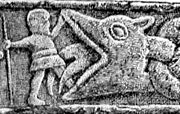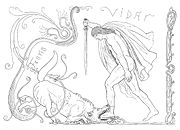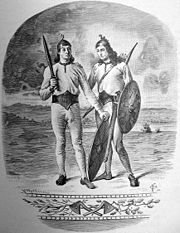
Vidar
Encyclopedia

Norse mythology
Norse mythology, a subset of Germanic mythology, is the overall term for the myths, legends and beliefs about supernatural beings of Norse pagans. It flourished prior to the Christianization of Scandinavia, during the Early Middle Ages, and passed into Nordic folklore, with some aspects surviving...
, Víðarr (Old Norse
Old Norse
Old Norse is a North Germanic language that was spoken by inhabitants of Scandinavia and inhabitants of their overseas settlements during the Viking Age, until about 1300....
, possibly "wide ruler", sometimes anglicized
Anglicisation
Anglicisation, or anglicization , is the process of converting verbal or written elements of any other language into a form that is more comprehensible to an English speaker, or, more generally, of altering something such that it becomes English in form or character.The term most often refers to...
as Vidar, Vithar, Vidarr, and Vitharr) is a god among the Æsir
Æsir
In Old Norse, áss is the term denoting a member of the principal pantheon in Norse paganism. This pantheon includes Odin, Frigg, Thor, Baldr and Tyr. The second pantheon comprises the Vanir...
associated with vengeance. Víðarr is described as the son of Odin
Sons of Odin
Various gods and men appear as Sons of Odin or Sons of Wodan/Wotan or Sons of Woden in old Old Norse and Old High German and Old English texts.-Thor, Baldur, and Váli:...
and the jötunn Gríðr, and is foretold to avenge his father's death by killing the wolf Fenrir at Ragnarök
Ragnarök
In Norse mythology, Ragnarök is a series of future events, including a great battle foretold to ultimately result in the death of a number of major figures , the occurrence of various natural disasters, and the subsequent submersion of the world in water...
, a conflict which he is described as surviving. Víðarr is attested in the Poetic Edda
Poetic Edda
The Poetic Edda is a collection of Old Norse poems primarily preserved in the Icelandic mediaeval manuscript Codex Regius. Along with Snorri Sturluson's Prose Edda, the Poetic Edda is the most important extant source on Norse mythology and Germanic heroic legends, and from the early 19th century...
, compiled in the 13th century from earlier traditional sources, the Prose Edda
Prose Edda
The Prose Edda, also known as the Younger Edda, Snorri's Edda or simply Edda, is an Icelandic collection of four sections interspersed with excerpts from earlier skaldic and Eddic poetry containing tales from Nordic mythology...
, written in the 13th century by Snorri Sturluson
Snorri Sturluson
Snorri Sturluson was an Icelandic historian, poet, and politician. He was twice elected lawspeaker at the Icelandic parliament, the Althing...
, and is interpreted as depicted with Fenrir on the Gosforth Cross
Gosforth cross
upright|thumb|Gosforth Cross outside St Mary's church in Gosforth.The Gosforth Cross is a large stone Anglo-Saxon high cross in the churchyard at Gosforth in the English county of Cumbria. Formerly part of the kingdom of Northumbria, the area was settled by Scandinavians some time in either the 9th...
. A number of theories surround the figure, including theories around potential ritual silence and a Proto-Indo-European
Proto-Indo-Europeans
The Proto-Indo-Europeans were the speakers of the Proto-Indo-European language , a reconstructed prehistoric language of Eurasia.Knowledge of them comes chiefly from the linguistic reconstruction, along with material evidence from archaeology and archaeogenetics...
basis.
Attestations

Poetic Edda
In the Poetic Edda, Víðarr is mentioned in the poems VöluspáVöluspá
Völuspá is the first and best known poem of the Poetic Edda. It tells the story of the creation of the world and its coming end related by a völva addressing Odin...
, Vafthrúdnismál, Grímnismál
Grímnismál
Grímnismál is one of the mythological poems of the Poetic Edda. It is preserved in the Codex Regius manuscript and the AM 748 I 4to fragment. It is spoken through the voice of Grímnir, one of the many guises of the god Odin, who is tortured by King Geirröth...
, and Lokasenna
Lokasenna
Lokasenna is one of the poems of the Poetic Edda. The poem presents flyting between the gods and Loki....
.
In stanzas 54 and 55 of the poem Völuspá, a völva
Völva
A vǫlva or völva is a shamanic seeress in Norse paganism, and a recurring motif in Norse mythology....
tells Odin that his son Víðarr will avenge Odin's death at Ragnarök by stabbing Fenrir in the heart. In stanzas 51 and 53 of Vafthrúdnismál , Vafþrúðnir
Vafþrúðnir
Vafþrúðnir is a wise jötunn in Norse mythology. In the Poetic Edda poem Vafþrúðnismál, Vafþrúðnir acts as both Odin's host and opponent in a deadly battle of wits, resulting in Vafþrúðnir's defeat....
states that Víðarr and his brother Váli
Vali
Vali or Wali can refer to:* Váli * Váli* Vali * The Vali tribe, a Sarmatian tribe of Ptolemy* Ferenc A. Váli, Hungarian-born lawyer, author and political analyst* Al-Walee, one of the Names of God in the Qur'an...
will both live in the "temples of the gods" after Surtr
Surtr
In Norse mythology, Surtr or Surt is an eldjötunn. Surtr is attested in the Poetic Edda, compiled in the 13th century from earlier traditional sources, and the Prose Edda, written in the 13th century by Snorri Sturluson...
's fire has ceded and that Víðarr will avenge the death of his father Odin by sundering the cold jaws of Fenrir in battle.
In stanza 17 of Grímnismál, during Odin's visions of various dwelling places of the gods, he describes Víðarr's (here anglicized as "Vidar") residence:
- Brushwood grows and high grass
- widely in Vidar's land
- and there the son proclaims on his horse's back
- that he's keen to avenge his father.
According to Lokasenna
Lokasenna
Lokasenna is one of the poems of the Poetic Edda. The poem presents flyting between the gods and Loki....
, Loki
Loki
In Norse mythology, Loki or Loke is a god or jötunn . Loki is the son of Fárbauti and Laufey, and the brother of Helblindi and Býleistr. By the jötunn Angrboða, Loki is the father of Hel, the wolf Fenrir, and the world serpent Jörmungandr. By his wife Sigyn, Loki is the father of Nari or Narfi...
rebukes the gods at the start of the poem for not properly welcoming him to the feast at Ægir's hall. In stanza 10, Odin finally relents to the rules of hospitality, urging Víðarr to stand and pour a drink for the quarrelsome guest. Víðarr does so, and then Loki toasts the Æsir before beginning his flyting
Flyting
Flyting or fliting is a contest consisting of the exchange of insults, often conducted in verse, between two parties.-Description:Flyting is a ritual, poetic exchange of insults practiced mainly between the 5th and 16th centuries. The root is the Old English word flītan meaning quarrel...
.
Prose Edda
Víðarr is referenced in the Prose Edda books GylfaginningGylfaginning
Gylfaginning, or the Tricking of Gylfi , is the first part of Snorri Sturluson's Prose Edda after Prologue. The Gylfaginning deals with the creation and destruction of the world of the Norse gods, and many other aspects of Norse mythology...
and Skáldskaparmál
Skáldskaparmál
The second part of Snorri Sturluson's Prose Edda the Skáldskaparmál or "language of poetry" is effectively a dialogue between the Norse god of the sea, Ægir and Bragi, the god of poetry, in which both Norse mythology and discourse on the nature of poetry are intertwined...
:
Gylfaginning
Víðarr is referenced in the book Gylfaginning in chapters 29, 51, and 53. In chapter 29, Víðarr is introduced by the enthroned figure of High as "the silent god" with a thick shoe, that he is nearly as strong as the god ThorThor
In Norse mythology, Thor is a hammer-wielding god associated with thunder, lightning, storms, oak trees, strength, the protection of mankind, and also hallowing, healing, and fertility...
, and that the gods rely on him in times of immense difficulties.
In chapter 51, High foretells that, during Ragnarök, the wolf Fenrir will devour Odin, Víðarr will avenge him by stepping down with one foot on the lower jaw of the monster, grabbing his upper jaw in one hand and tearing his mouth apart, killing him. Víðarr's "thick shoe" is described as consisting of all the extra leather pieces that people have cut from their own shoes at the toe and heel, collected by the god throughout all time. Therefore, anyone who is concerned enough to give assistance to the gods should throw these pieces away.
In chapter 54, following Ragnarök and the rebirth of the world, Víðarr along with his brother Váli
Váli (son of Odin)
In Norse mythology, Váli is a son of the god Odin and the giantess Rindr. He was birthed for the sole purpose of killing Höðr as revenge for Höðr's accidental murder of his half-brother, Baldr. He grew to full adulthood within one day of his birth, and slew Höðr...
will have survived both the swelling of the sea and the fiery conflagration unleashed by Surtr
Surtr
In Norse mythology, Surtr or Surt is an eldjötunn. Surtr is attested in the Poetic Edda, compiled in the 13th century from earlier traditional sources, and the Prose Edda, written in the 13th century by Snorri Sturluson...
, completely unharmed, and shall thereafter dwell on the field Iðavöllr, "where the city of Asgard
Asgard
In Norse religion, Asgard is one of the Nine Worlds and is the country or capital city of the Norse Gods surrounded by an incomplete wall attributed to a Hrimthurs riding the stallion Svadilfari, according to Gylfaginning. Valhalla is located within Asgard...
had previously been".
Skáldskaparmál
According to SkáldskaparmálSkáldskaparmál
The second part of Snorri Sturluson's Prose Edda the Skáldskaparmál or "language of poetry" is effectively a dialogue between the Norse god of the sea, Ægir and Bragi, the god of poetry, in which both Norse mythology and discourse on the nature of poetry are intertwined...
, Víðarr was one of the twelve presiding male gods seated in their thrones at a banquet for the visiting Ægir
Ægir
Ægir is a sea giant, god of the ocean and king of the sea creatures in Norse mythology. He is also known for hosting elaborate parties for the gods.Ægir's servants are Fimafeng and Eldir.- Description :...
. At a point in dialogue between the skald
Skald
The skald was a member of a group of poets, whose courtly poetry is associated with the courts of Scandinavian and Icelandic leaders during the Viking Age, who composed and performed renditions of aspects of what we now characterise as Old Norse poetry .The most prevalent metre of skaldic poetry is...
ic god Bragi
Bragi
Bragi is the skaldic god of poetry in Norse mythology.-Etymology:Bragi is generally associated with bragr, the Norse word for poetry. The name of the god may have been derived from bragr, or the term bragr may have been formed to describe 'what Bragi does'...
and Ægir, Snorri
Snorri Sturluson
Snorri Sturluson was an Icelandic historian, poet, and politician. He was twice elected lawspeaker at the Icelandic parliament, the Althing...
himself begins speaking of the myths in euhemeristic terms and states that the historical equivalent of Víðarr was the Trojan
Troy
Troy was a city, both factual and legendary, located in northwest Anatolia in what is now Turkey, southeast of the Dardanelles and beside Mount Ida...
hero Aeneas
Aeneas
Aeneas , in Greco-Roman mythology, was a Trojan hero, the son of the prince Anchises and the goddess Aphrodite. His father was the second cousin of King Priam of Troy, making Aeneas Priam's second cousin, once removed. The journey of Aeneas from Troy , which led to the founding a hamlet south of...
who survived the Trojan War
Trojan War
In Greek mythology, the Trojan War was waged against the city of Troy by the Achaeans after Paris of Troy took Helen from her husband Menelaus, the king of Sparta. The war is among the most important events in Greek mythology and was narrated in many works of Greek literature, including the Iliad...
and went on to achieve "great deeds".
Later in the book, various kennings are given for Víðarr, including again the "silent As
Æsir
In Old Norse, áss is the term denoting a member of the principal pantheon in Norse paganism. This pantheon includes Odin, Frigg, Thor, Baldr and Tyr. The second pantheon comprises the Vanir...
", "possessor of the iron shoe", "enemy and slayer of Fenrisulf", "the gods' avenging As", "father's homestead-inhabiting As", "son of Odin", and "brother of the Æsir". In the tale of the god Thor
Thor
In Norse mythology, Thor is a hammer-wielding god associated with thunder, lightning, storms, oak trees, strength, the protection of mankind, and also hallowing, healing, and fertility...
's visit to the hall of the jötunn Geirröd
Geirröd
In Norse mythology, Geirröd was a jötunn and the father of the giantesses Gjálp and Greip.The story of Geirröd is told in Þórsdrápa. Loki, while flying as a hawk, was captured by Geirröd. Because he hated Thor, Geirröd demanded that Loki bring his enemy to Geirröd's castle without his magic belt...
, Gríðr is stated as the mother of "Víðarr the Silent" who assists Thor in his journey. In chapter 33, after returning from Asgard and feasting with the gods, Ægir invites the gods to come to his hall in three months. Fourteen gods make the trip to attend the feast, including Víðarr. In chapter 75, Víðarr's name appears twice in a list of Æsir.
Archaeological record

Gosforth cross
upright|thumb|Gosforth Cross outside St Mary's church in Gosforth.The Gosforth Cross is a large stone Anglo-Saxon high cross in the churchyard at Gosforth in the English county of Cumbria. Formerly part of the kingdom of Northumbria, the area was settled by Scandinavians some time in either the 9th...
, located in Cumbria
Cumbria
Cumbria , is a non-metropolitan county in North West England. The county and Cumbria County Council, its local authority, came into existence in 1974 after the passage of the Local Government Act 1972. Cumbria's largest settlement and county town is Carlisle. It consists of six districts, and in...
, England, has been described as depicting a combination of scenes from the Christian Judgement Day and the pagan Ragnarök. The cross features various figures depicted in Borre style
Borre style
Borre style is a Viking Era animal ornamentation which was first named after artifacts from a boat grave in Borre mound cemetery near the village of Borre, in Horten municipality, Vestfold county, Norway.-History:...
, including a man with a spear facing a monstrous head, one of whose feet is thrust into the beast's forked tongue and on its lower jaw, while a hand is placed against its upper jaw, a scene interpreted as Víðarr fighting Fenrir. The depiction has also been theorized as a metaphor for Jesus's defeat of Satan.
Theories


Baldrs draumar
Baldrs draumar or Vegtamskviða is an Eddic poem, contained in the manuscript AM 748 I 4to. It relates information on the myth of Baldr's death in a way consistent with Gylfaginning....
when Váli, conceived for the sole purpose of avenging Baldr's death, abstains from washing his hands and combing his hair "until he brought Baldr's adversary to the funeral pyre". Parallels have been drawn between chapter 31 of Tacitus
Tacitus
Publius Cornelius Tacitus was a senator and a historian of the Roman Empire. The surviving portions of his two major works—the Annals and the Histories—examine the reigns of the Roman Emperors Tiberius, Claudius, Nero and those who reigned in the Year of the Four Emperors...
' 1st century CE
Common Era
Common Era ,abbreviated as CE, is an alternative designation for the calendar era originally introduced by Dionysius Exiguus in the 6th century, traditionally identified with Anno Domini .Dates before the year 1 CE are indicated by the usage of BCE, short for Before the Common Era Common Era...
work Germania
Germania (book)
The Germania , written by Gaius Cornelius Tacitus around 98, is an ethnographic work on the Germanic tribes outside the Roman Empire.-Contents:...
where Tacitus describes that members of the Chatti
Chatti
The Chatti were an ancient Germanic tribe whose homeland was near the upper Weser. They settled in central and northern Hesse and southern Lower Saxony, along the upper reaches of the Weser River and in the valleys and mountains of the Eder, Fulda and Weser River regions, a district approximately...
, a Germanic tribe
Germanic peoples
The Germanic peoples are an Indo-European ethno-linguistic group of Northern European origin, identified by their use of the Indo-European Germanic languages which diversified out of Proto-Germanic during the Pre-Roman Iron Age.Originating about 1800 BCE from the Corded Ware Culture on the North...
, may not shave or groom before having first slain an enemy.
Georges Dumézil
Georges Dumézil
Georges Dumézil was a French comparative philologist best known for his analysis of sovereignty and power in Proto-Indo-European religion and society...
theorized that Víðarr represents a cosmic figure from an archetype derived from the Proto-Indo-Europeans
Proto-Indo-Europeans
The Proto-Indo-Europeans were the speakers of the Proto-Indo-European language , a reconstructed prehistoric language of Eurasia.Knowledge of them comes chiefly from the linguistic reconstruction, along with material evidence from archaeology and archaeogenetics...
. Dumézil stated that he was aligned with both vertical space, due to his placement of his foot on the wolf's lower jaw and his hand on the wolf's upper jaw, and horizontal space, due to his wide step and strong shoe, and that, by killing the wolf, Víðarr keeps the wolf from destroying the cosmos, and the cosmos can thereafter be restored after the destruction resulting from Ragnarök
Ragnarök
In Norse mythology, Ragnarök is a series of future events, including a great battle foretold to ultimately result in the death of a number of major figures , the occurrence of various natural disasters, and the subsequent submersion of the world in water...
.

